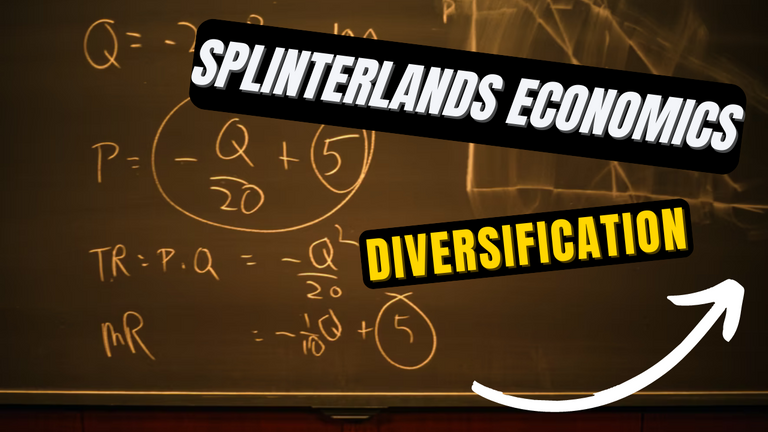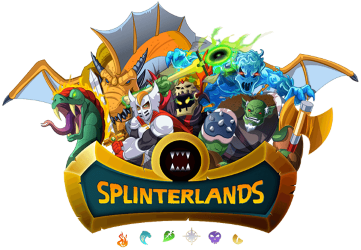Splinterlands Economics: Diversification
Hello everyone! We are back again today with another edition of Splinterland Economics - a series in which we introduce a basic economic concept and then apply it to Splinterlands. If this is your first time reading, just to tell you a little bit about myself: my day job is in an unrelated area but I consider myself a little bit of economics nerd - I read a little (or maybe way, way) more news than I should, double majored in econ, and am obsessed with optimization. I love the way Splinterlands is equal parts card game and resource allocation game. My goal with these articles is to share a little bit of what I know with you all.
Our subject today is a relatively simple concept, but one which may have even more benefits than you may expect at first glance. While it can also be applied to the workplace and other areas, in this post we will be spending a good portion of our discussion looking at its uses in asset allocation. Today, we will be talking about diversification!

What is diversification?
As I mentioned at the start this is - at face value at least - a simple idea. Diversification is mixing a variety of different things. Diversification may be applied to many different areas. A university may attempt to admit a diverse student body by trying to attract students from a wide variety of backgrounds. A restaurant may diversify its menu by offering different types of dishes or cuisines. When it comes to investing and asset allocation, diversification means holding different types of investments.
Diversity comes with a whole array of potential benefits. Going back to our previous examples, exposure to people with different backgrounds or cultures may give people a better appreciation for other viewpoints or ways of doing things, and diversity in a business' offerings allows customers to choose between a wider array of options and may result in them finding a product which they enjoy more. Of course there are also associated costs - greater potential for misunderstandings, less of a focus on a specialty, or overwhelming customers with decisions. However, in many cases diversifying can be something which should at least be worth thinking about.
In investing, diversification reduces your risk to individual companies or events. This can be achieved by holding different asset classes, companies, or items. Notably, if your goal is to diversify, then you should attempt to hold assets which are not closely correlated. For example, if you purchase 10 different semiconductor manufacturers then you may be reducing the risk of a single company having unforeseen problems, but an event which harms the semiconductor industry as a whole can do some serious damage to your portfolio. So while evaluating your investments, it may be beneficial to take a second look at where you have your money parked - is it REALLY diversified? Or have you bought a collection of closely related assets?
How do we apply it to Splinterlands?
Many investors will purchase a mix of stocks and bonds for their portfolio. This can also be supplemented by alternative investments including real estate, collectibles, and yes, crypto. While I personally enjoy Splinterlands as a game and do not view it as an investment (or at least, a serious one), there are many players who have significant investment or "skin in the game" when it comes to the Splinterlands ecosystem. This is not a bad thing, and in fact can actually be a good thing depending on the person and the situation. As a game existing on a blockchain and in the web3 space, Splinterlands can be viewed as an investment in the crypto area. This offers the potential for diversifying a portfolio by investing crypto (including Splinterlands!) in order to bring more variety into the mix of assets.
Within the Splinterlands ecosystem itself there are also opportunities to diversify. There are a wide range of assets with value. Currencies (such as DEC, SPS, and Vouchers), cards of various editions, and semi-speculative items such as land or totems are all potential places for you to invest your money. If you have a strong reason to believe that one asset will outperform the market then by all means feel free to move all of your money into that area, but otherwise you may want to think about diversifying and buying a little bit of several different things. That way you will at least do decently, regardless of which specific Splinterlands assets end up being the best to be holding.
Why should we care?
One thing I should note about diversification is that (as always!) its benefits come at a cost. By diversifying, you lose out on the best case scenario of putting all of your money into the single place where it can earn you the greatest amount of gains. However, for the vast majority of us, the future is uncertain. We have no time machine or crystal ball, and have no way of determining in advance what will happen to prices in the future. For those of us in this situation, diversification is a powerful tool to hedge in our investments and minimize downward risks to our hard earned savings.
Thank you so much for reading all the way to the end. Interested in seeing some more of my writing in the future? Be sure to give me a follow! In the meantime, if you'd like to see some of my recent posts:
Splinterlands Economics: Exchange Rates - An overview of the concept of exchange rates, and how we can apply it to Splinterlands!
A Quick Burn - Using Fire in Battle! - Last week's battle challenge, featuring the Fire splinter!
Splinterlands Economics: Government - An overview of the role of government in economics, and how we can apply it to Splinterlands!
Thinking about giving Splinterlands a try but haven't signed up yet? Feel free to use my referral link: https://splinterlands.com?ref=bteim, and be sure to reach out to me if you have any questions!
All images used in this article are open source and obtained from Pixabay or Unsplash. Thumbnails borrowed with permission from the Splinterlands team or made in [Canva](https://www.canva.com.




https://twitter.com/1467643672636190720/status/1615733175027916801
The rewards earned on this comment will go directly to the people( @bteim ) sharing the post on Twitter as long as they are registered with @poshtoken. Sign up at https://hiveposh.com.
Thanks for sharing! - @alokkumar121
